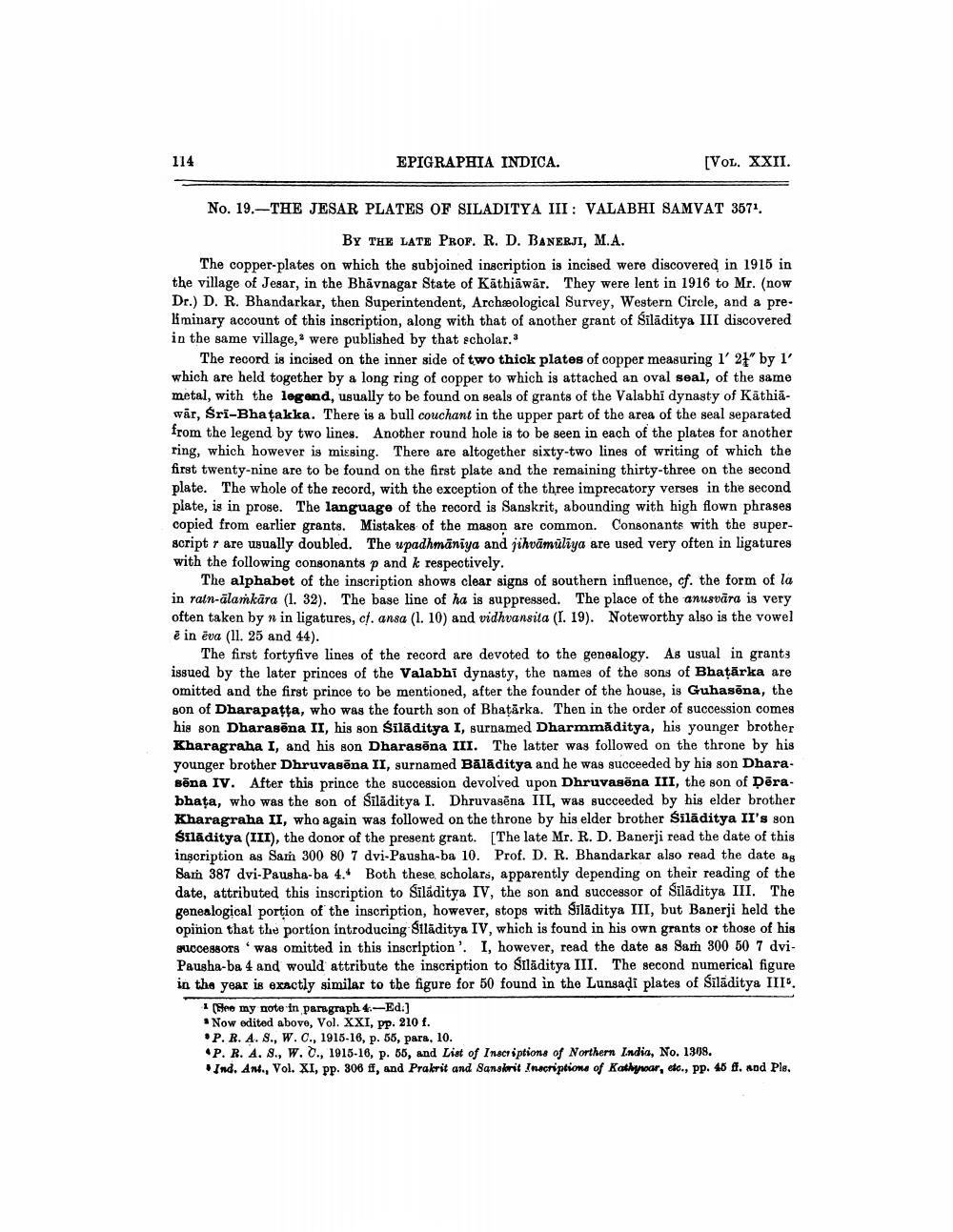________________
114
EPIGRAPHIA INDICA.
[VOL. XXII.
No. 19.-THE JESAR PLATES OF SILADITYA III: VALABHI SAMVAT 3571.
BY THE LATE PROF. R. D. BANERJI, M.A. The copper-plates on which the subjoined inscription is incised were discovered in 1915 in the village of Jesar, in the Bhāvnagar State of Käthjāwar. They were lent in 1916 to Mr. (now Dr.) D. R. Bhandarkar, then Superintendent, Archaeological Survey, Western Circle, and a preliminary account of this inscription, along with that of another grant of Milāditya III discovered in the same village, were published by that scholar.3
The record is incised on the inner side of two thick plates of copper measuring 1' 21" by 1' which are held together by a long ring of copper to which is attached an oval seal, of the same metal, with the legend, usually to be found on seals of grants of the Valabhi dynasty of Kathiawār, Sri-Bhatakka. There is a bull couchant in the upper part of the area of the seal separated from the legend by two lines. Another round hole is to be seen in each of the plates for another ring, which however is missing. There are altogether sixty-two lines of writing of which the first twenty-nine are to be found on the first plate and the remaining thirty-three on the second plate. The whole of the record, with the exception of the three imprecatory verses in the second plate, is in prose. The language of the record is Sanskrit, abounding with high flown phrases copied from earlier grants. Mistakes of the mason are common. Consonants with the superscript r are usually doubled. The upadhmāniya and jihvāmülīya are used very often in ligatures with the following consonants p and k respectively.
The alphabet of the inscription shows clear signs of southern influence, cf. the form of la in rain-ālamkara (1. 32). The base line of ha is suppressed. The place of the anusvāra is very often taken by n in ligatures, cf. ansa (1. 10) and vidhvansita (I. 19). Noteworthy also is the vowel è in eva (11. 25 and 44).
The first fortyfive lines of the record are devoted to the genealogy. As usual in grants issued by the later princes of the Valabhi dynasty, the names of the sons of Bhaṭārka are omitted and the first prince to be mentioned, after the founder of the house, is Guhasēna, the son of Dharapatta, who was the fourth son of Bhaţārka. Then in the order of succession comes his son Dharasēna II, his son Śīlāditya I, surnamed Dharmmāditya, his younger brother Kharagraha I, and his son Dharasēna III. The latter was followed on the throne by his younger brother Dhruvasēna II, surnamed Bālāditya and he was succeeded by his son Dharasēna IV. After this prince the succession devolved upon Dhruvagēna III, the son of pērabhata, who was the son of Silāditya I. Dhruvasēna IIL, was succeeded by his elder brother Kharagraha II, who again was followed on the throne by his elder brother Silāditya II's son Silāditya (III), the donor of the present grant. [The late Mr. R. D. Banerji read the date of this inscription as Sam 300 80 7 dvi-Pausha-ba 10. Prof. D. R. Bhandarkar also read the date ag Sarn 387 dvi-Pausha-ba 4. Both these, scholars, apparently depending on their reading of the date, attributed this inscription to Sīlāditya IV, the son and successor of Silāditya III. The genealogical portion of the inscription, however, stops with Sīlāditya III, but Banerji held the opinion that the portion introducing Siladitya IV, which is found in his own grants or those of his guccessors was omitted in this inscription'. I, however, read the date as Sam 300 50 7 dviPausha-ba 4 and would attribute the inscription to Silāditya III. The second numerical figure in the year is exactly similar to the figure for 50 found in the Lunsadi plates of Silāditya III.
See my note in paragraph 4.-Ed.) * Now edited above, Vol. XXI, pp. 210 f. *P. R. A. 8., W. C., 1915-16, p. 55, para, 10.
P. R. A. 8., W.O., 1915-16, p. 58, and List of Inscriptions of Northern India, No. 1308. Ind. Ant., Vol. XI, pp. 308 f, and Prakrit and Sanskrit Inscriptions of Kathyroar, etc., pp. 45 ff. and Pls.




